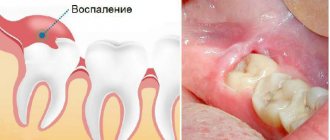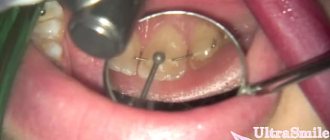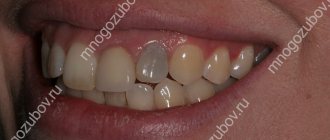In modern dentistry, there are many indications for tooth extraction. Such interventions are often accompanied by complications such as pain and swelling [1]. Moreover, pain, which mainly occurs due to the inflammatory reaction, is one of the most common and significant complications [2]. Painful stimuli during surgery or in the postoperative period can cause changes in the nervous system and affect pain levels. The first 12 hours after the effect of local anesthesia has subsided are the most difficult for the patient, since it is at this time that the pain reaches its peak. Effective pharmacological correction during this period helps not only to reduce the development of complications, but also to rapid wound healing [3]. For this purpose, non-steroidal anti-inflammatory drugs are most often used, the favorite among which is ketarolac, as it has a powerful analgesic effect similar to opioids [4], as well as moderate anti-inflammatory activity [5].
The purpose of our study is to substantiate the use of a new form of the drug Ketorol Express for pain relief based on determining the speed of onset and duration of the analgesic effect after complex tooth extraction.
Composition and release form
Ketorol is available in two pharmacological forms - tablets and injections. The active ingredient in its composition is ketorolac. It has a powerful anti-inflammatory effect and is even used to relieve severe toothaches caused by pulpitis or maxillofacial injuries.
In addition to the active substance, the tablets contain lactose and starch. For people who are allergic to milk protein, it is better to give preference to the drug in the form of injections. The effect of Ketorol in the fight against pain is often equated to the therapeutic effect of narcotic medications. But adverse reactions from its use are observed much less frequently.
How long does pain last?
How many days do teeth hurt after whitening is the second most popular question after the cost of the service. Everything is individual and depends on the state of health and characteristics of the human body.
When lightening is carried out correctly, the discomfort goes away immediately after the procedure - as soon as the active composition is removed from the tooth surface. But with increased sensitivity of the enamel, it can last for a short time.
The discomfort completely disappears on the second or third day. In some cases, the period may extend to 5-10 days.
How long teeth hurt after whitening is also influenced by the patient’s behavior. It is important to follow the doctor’s recommendations to speed up the recovery process and avoid consequences.
Therapeutic effect
Ketorol can only relieve the symptoms of dental diseases, but not treat them. It is only suitable for temporary relief when it is not possible to urgently consult a doctor. Patients who took potent medications for a long time and did not turn to specialists ended up completely losing problem units without the possibility of restoring them using conservative methods.
Ketorol does not cause addiction in the body, unlike other NSAID drugs, but this does not mean that you can exceed its dosage established in the instructions.
It is not advisable to take Ketorol tablets on your own without first consulting a doctor. Any medication can cause unpredictable reactions from the body. This is especially true for people with severe chronic diseases.
Clinical methods
If after lightening your teeth become overly sensitive and susceptible to pain, this is not a reason to give up the desired dazzling smile. Teeth hurt after whitening - this can be corrected in one or several visits to the dentist with the help of fluoridation, remotherapy or remineralization with electrophoresis.
During the procedure, tissues are saturated with useful substances, strengthened, restored and increased resistance to external irritants. Therefore, even if the tooth surface is damaged during lightening, it will quickly return to normal.
We looked at the main options for when teeth hurt after whitening, how to soothe the pain and how to relieve surface hypersensitivity. But if you experience severe, persistent pain, you should immediately consult a specialist.
Operating principle
The main component of Ketorol has the ability to be absorbed from the intestines into the blood. It quickly penetrates the internal organs and tissues, thereby providing a rapid therapeutic effect. Ketorolac (active ingredient) has the ability to suppress the activity of enzymes that cause the production of prostaglandins. The substances are responsible for the susceptibility of pain, the development of the inflammatory process and an increase in body temperature.
Not all prostaglandins affect the development of the inflammatory process; some of them are necessary to protect the mucous membranes of the stomach from external irritants. 1st generation NSAIDs, which include Ketorol, block all types of hormones, therefore, with long-term use, an exacerbation of gastrointestinal diseases is possible. Because of this, the patient may feel discomfort in the upper abdomen. NSAIDs of the latest generations selectively block only those substances that are responsible for pain receptors and increased temperature.
In what cases is it necessary to remove the nerve of a tooth?
Removing the nerve from a tooth kills it. Almost no nutrients are supplied, causing it to become darker and weaker. During treatment, dentists try to keep the dental nerve alive, but sometimes they have to take forced measures to put the oral cavity in order.
Nerve removal is necessary if:
- Deep caries.
If the disease has destroyed almost the entire tooth, there is nothing to save; the main thing for the doctor is to prevent further destructive process.
- Prosthetics.
To install the prosthesis, an incision must be made in the pulp chamber. This is especially necessary in situations where teeth grow at an inclined angle.
- Incorrect treatment in the past.
This can happen if during treatment the doctor resorted to opening the pulp chamber. In this case, it is necessary to partially remove the nerve.
- Mechanical damage.
Injury can lead to chips in the enamel where the nerve is located. If the front teeth are damaged, the nerve is not completely removed.
Antibiotic therapy after removal of unhealthy teeth
Antibiotics are prescribed by the attending physician - dentist. Drugs are prescribed in case of difficult extraction, to prevent the risk of complications if the tooth was removed due to inflammatory processes.
The drug usually prescribed is Lincomycin 0.25. Take capsules after tooth extraction for 5 days, 2 capsules 3 times. If purulent inflammation is present, the antibiotic is prescribed as intramuscular injections.
Those who suffer from intestinal and stomach disorders can take antibiotics in effervescent forms, for example, Unidox Solutab and Flemoxin Solutab.
Indications for use for toothache
Ketorol is taken for toothaches manifested due to:
- medium form of caries;
- pulpitis;
- dental granulomas;
- osteomyelitis;
- maxillofacial injuries;
- cysts;
- flux;
- tooth extraction;
- pericoronitis,
- implantation or other surgical intervention.
Taking Ketorol in tablets or ampoules for more than 5 days is not recommended.
If the drug helps relieve toothaches, you should still consult a dentist. There is a high probability that discomfort will appear in the near future and will manifest itself with a greater degree of severity.
After implantation and surgical intervention, medicine containing ketorolac is also allowed to be taken for no more than 5 days. If after surgery the pain does not subside or intensifies, you should make an appointment with a specialist again. Severe discomfort after the intervention may be associated with the addition of a secondary infection to the problem area. In this case, Ketorol is useless.
If your gums bleed after tooth extraction
You can stop bleeding in a number of effective ways. In most cases, this disease affects people with high blood pressure with hypertension or patients who have had a large vessel damaged.
It is worth noting that due to psychological overload and stress during activities, even in people with normal health, blood pressure may rise. The first step is to apply a tightly rolled piece of sterile bandage to the bleeding site, and then measure the patient’s blood pressure. If it is elevated, you need to resort to medications.
With increased blood pressure, the chance of hematoma and blood appearing after tooth extraction increases. This development of events is dangerous due to suppuration, which will then have to be opened, and bleeding can cause dizziness and weakness.
If bleeding appears several hours after removal, you should not wait for the situation to normalize, but seek medical help.
Diabetes mellitus during tooth extraction
If a person has this disease, it is recommended to measure their sugar levels immediately after surgery. Tension leads to the production of adrenaline, which can increase the rate. By measuring sugar, a person will know about his condition and will be able to prevent side effects.
If a gauze pad is placed on the gum
A gauze swab is placed on the hole if it is etching. In other situations, the use of this remedy is undesirable, as it can provoke inflammation. As the tissue is removed, the blood clot that has formed in the socket is also removed.
If the tissue lining is on the wound, it is necessary to carefully remove it after a certain period of time after removing the tooth. A tampon that has absorbed a certain amount of liquid automatically becomes a breeding ground for a wide range of bacteria. You should not keep it in your mouth for a long time to prevent the appearance of inflammatory processes in the hole that remains after tooth extraction.
Antiseptic rinses for suppurations
There is no need to rinse your mouth intensively; instead, use “baths”. In order not to disturb the damaged tissues, take a special anti-inflammatory solution into your mouth, keep it inside, and then spit it out.
Contraindications
There are several prohibitions on taking the drug Ketorol. Among them are:
- pregnancy at any stage;
- breastfeeding (the active substance is absorbed into breast milk and enters the baby’s intestines);
- children under 16 years of age;
- severe renal or liver failure;
- allergy to auxiliary and active substances of the medication;
- diseases of the digestive tract that occur in acute form (gastritis, duodenal ulcer).
The instructions for use list in detail all diseases for which taking the medication is contraindicated. If you notice any side effects from treatment, you should immediately stop taking the medication and consult a doctor. Ketorol has analogues in terms of therapeutic action and duration of analgesic effect. One of the analogues of the drug with the same active ingredient is Nimesil, but unlike Ketorol it is produced in a more convenient form for use - in granules.
Instructions for use
When relieving tooth pain, Ketorol is used taking into account certain rules:
The best remedy for toothache
- The dosage of the drug is calculated separately for each specific case, depending on the patient’s body weight and the severity of the symptoms of the disorder.
- It is allowed to take no more than 10 mg of the drug at a time. The maximum daily dosage of Ketorol is 40 mg.
- Use the medication in minimal dosages to relieve dental pain in patients under 18 and over 65 years of age.
- To quickly eliminate discomfort, use the product in the form of injections for injections. How long does it take for the drug to work? The effect of using the solution is observed after 15–20 minutes. Ketorol in tablet form acts within 30–40 minutes.
- During treatment, exclude fatty foods from your diet. It can reduce the rate of absorption of the active substance in the intestine.
Children under 16 years of age are prohibited from taking Ketorol for toothache. But with the permission of the doctor, injections can be used to relieve severe pain. Children are administered the solution intramuscularly in minimal dosages.
When you shouldn't go to the doctor
Often, when eating, we are faced with the fact that our teeth respond to us with incomprehensible “signals” - they begin to “cramp” and itching appears. You shouldn’t immediately sound the alarm - these may not be signs of dental disease, but simply evidence of illiterate food intake. This reaction is often caused by eating food that is too cold or too warm, or, even worse, by suddenly changing cold and hot foods (and vice versa).
Sudden changes in temperature not only cause toothache, but can also seriously damage tooth enamel. You shouldn’t eat ice cream after a cup of hot coffee - this could result in your tooth simply cracking! If a tooth hurts due to temperature changes, the toothache itself in such cases does not pose a danger - it is a reaction of your teeth to a “stressful” situation for them.
Another feature of the body that can cause toothache is the teeth’s sensitive response to weather changes. Sub-zero temperatures and icy cold can cause minor toothache, which will not be a sign of serious illness. This is a normal reaction of the body to weather conditions. To reduce discomfort from extremely cold temperatures, wear warm hats, turtleneck sweaters, and scarves that cover your neck and lower face.
Side effects and overdose
The most common consequences after treatment with Ketorol are disruption of the gastrointestinal tract. It is manifested by flatulence, a feeling of heaviness in the stomach and diarrhea. Typically, such manifestations occur in people over 65 years of age, since they are often diagnosed with chronic diseases of the gastrointestinal tract.
Other possible side effects from taking Ketorol include:
- excessive sweating;
- allergic reactions, manifested by skin rashes and difficulty breathing;
- swelling and redness of the face;
- dizziness;
- headache.
The likelihood of adverse reactions occurring depends on the dosage of the drug taken and the time for which it is taken. When overdosing on painkillers, people experience symptoms of intoxication:
- vomit;
- nausea;
- dehydration.
If these signs appear, you must rinse your stomach with water and take the sorbent. After this, Ketorol is stopped until you feel better.
Proper oral care after tooth extraction
To prevent unwanted consequences from occurring, it is important not to do the following:
- touch the wound with your tongue or use other foreign objects for this,
- rinse your mouth generously in the first two days,
- make sudden movements with the facial muscles,
- plunge into hot water or rinse with it,
- Hard to work,
- eat food in the first 3 hours that follow the procedure, it is permissible to drink, but refrain from boiling water.
- You should also abstain from cigarettes at this time,
- alcohol is contraindicated within 24 hours after surgery. If your doctor prescribes the use of antibiotics, you should not drink alcohol until the end of the course of therapy.
Analogs
Drugs similar in therapeutic effect to Ketorol - Ketorolac, Ketanov, Nise. What's best to drink for toothaches? Ketarolac and Ketorol have the same active ingredient, so the effect of their use is the same. Both medications are used not only to relieve toothaches. They are an excellent help in eliminating discomfort caused by neuralgia, myalgia, injuries and oncology.
Nise contains nimesulide as an active ingredient. Nimesulide selectively affects the production of hormones. due to this, it has fewer side effects than Ketorol. It is recommended to use Nise to relieve severe inflammation. Ketorol copes better with severe pain.
Nise, in addition to the tablet form, is available in the form of a suspension and gel for topical use
Interaction with other drugs
Ketorol should not be taken with the following types of medications:
- with acetylsalicylic acid;
- other NSAIDs;
- glucocorticosteroids;
- calcium supplements;
- ethyl alcohol.
A combination of Ketorol with the following dosage forms can cause dysfunction of other organs and systems:
- Vazolapril, Captopril - kidney problems occur.
- Fluoxent, heparin, thrombolytics - increases the likelihood of internal bleeding;
- Pipecuronium, Tubocurarine - cause shortness of breath;
- Antiepileptic drugs – increase the risk of hallucinations.
The effect of Ketorol is significantly reduced when combined with hydrocortisone and morphine. The approximate cost of a package with 20 tablets is 50 rubles. Ampoules with a solution for intramuscular administration (10 pieces) cost 150 rubles.
Reviews
Anna, Kirov. “I always took Ketorol for toothaches. After using it I do not experience any side effects. While after its analogue Ketanov I felt very sick. However, I do not recommend drinking Ketoroll often, because it is a powerful drug. It is only suitable for emergency use, when there is no time or opportunity to see a doctor and the tooth hurts badly. The instructions also say that drinking Ketorol is not recommended during exacerbation of chronic diseases.”
Larisa, Saratov. “I have sensitive enamel by nature. Even with superficial caries, they feel very strong throbbing pain. In such cases, Nise or Ketorol helps me out. I don’t try to take pills for every occasion. Still, it is better to endure the pain and consult a doctor as soon as possible. I take these medications only if I can’t sleep or I understand that I won’t be able to see a doctor anytime soon.”
Andrey, Lipetsk. “I won’t take Ketorol even if my leg is broken. I bought it for a toothache and read the instructions before using it. It contained such a large list of side effects that I was afraid to take the pills. After taking Ketorol, a friend’s gastroduodenitis worsened so much that he was urgently hospitalized. I advise you to look for milder painkillers.”
Oral hygiene
It is not carried out on the first day to exclude infection and accidental injury. Chlorhexidine can be used almost immediately after tooth extraction, as it does not cause side effects; the main thing is to rinse carefully and according to the instructions. Further hygienic cleaning can be performed once a day with a soft brush, carefully avoiding the surgical area.
Floss is also used to remove food debris from between teeth and a warm saline solution is used to rinse the mouth after each meal. Do not forget about cleansing your tongue, as plaque also accumulates on it, in which bacteria actively multiply.
Removal of sutures after tooth extraction occurs on the 7th - 10th day. By this time, the wounds have already healed and restrictions on hygiene procedures are lifted. Cleaning is carried out twice: in the morning and in the evening.










